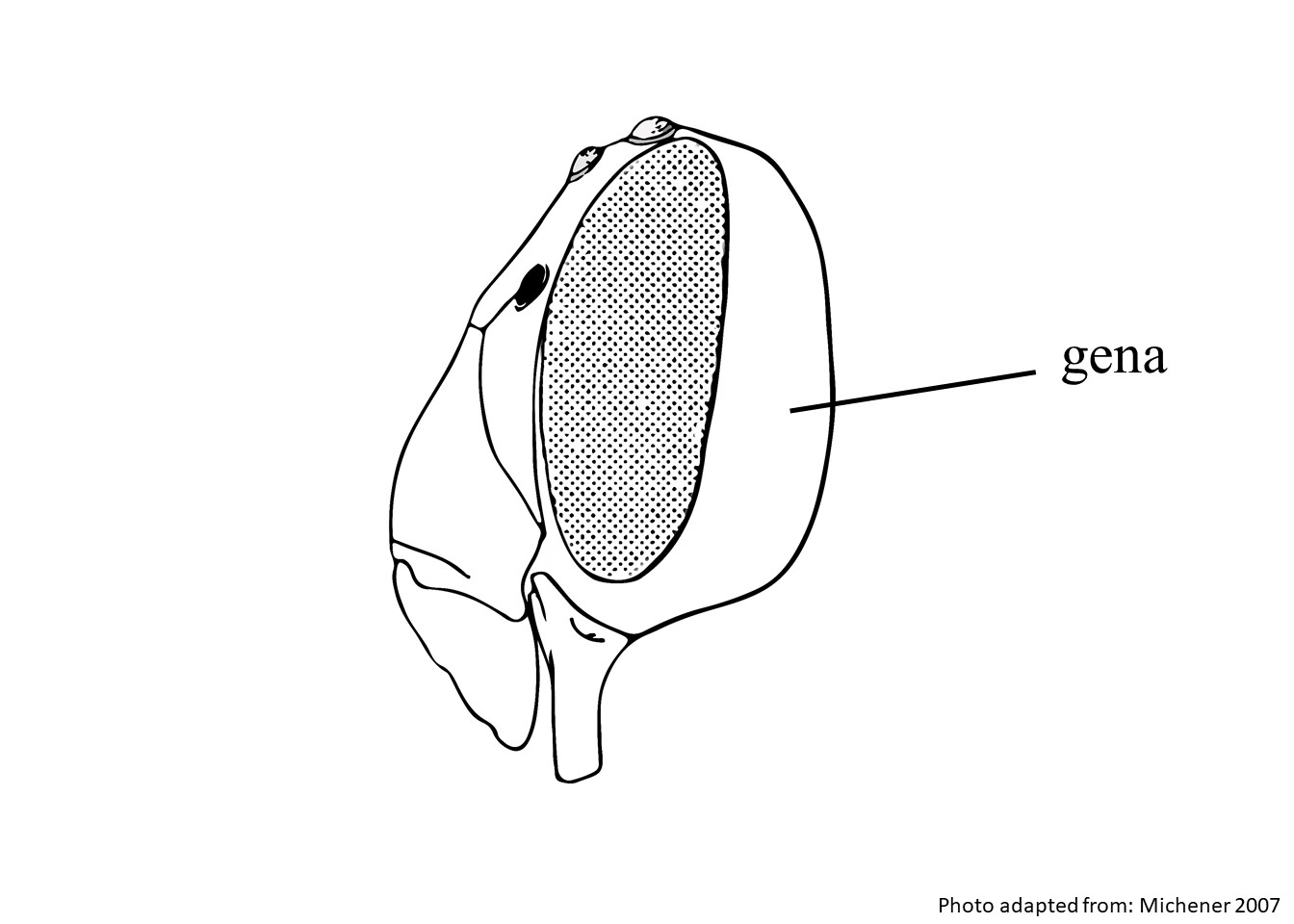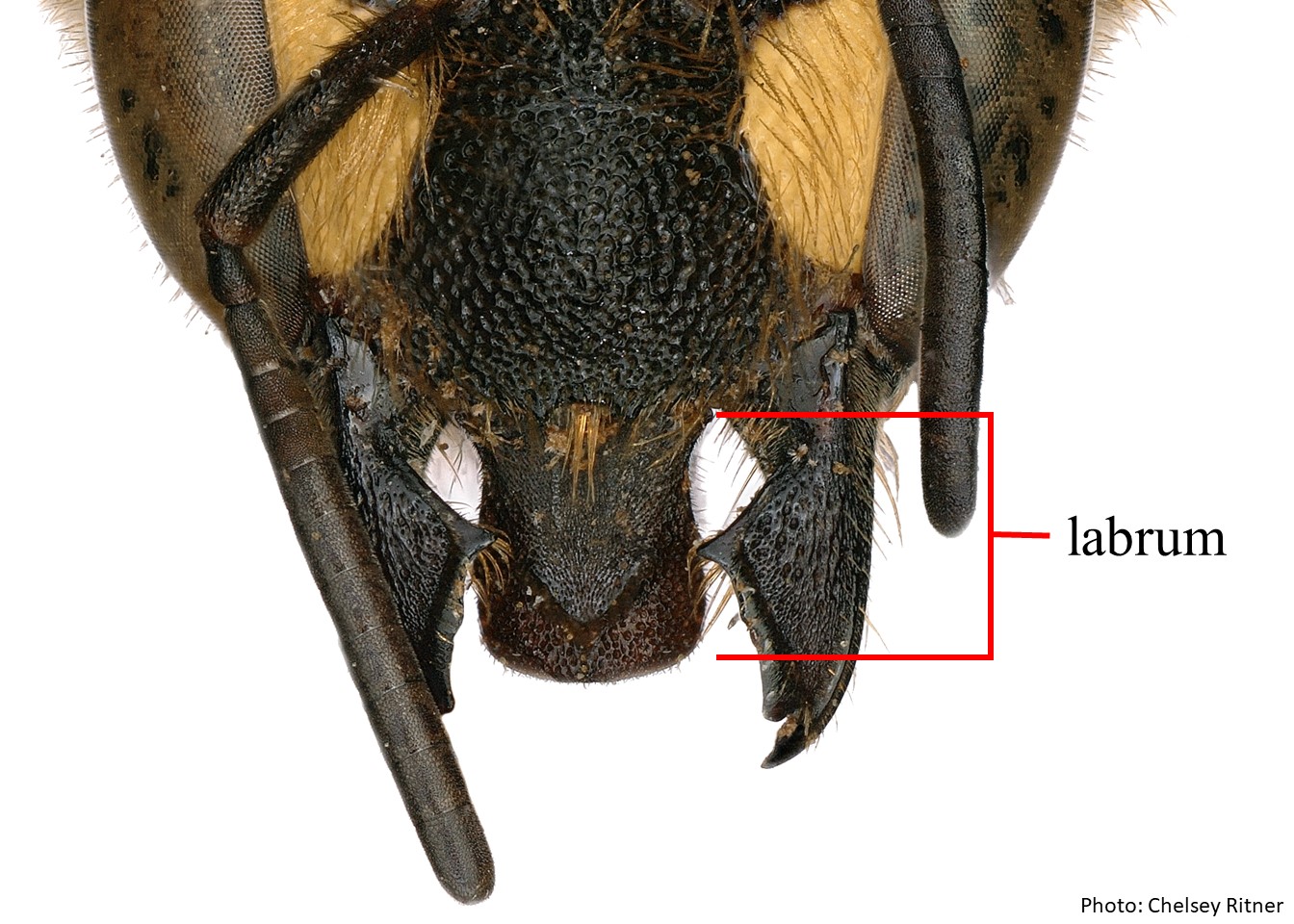Family: Megachilidae
Subfamily: Megachilinae
Tribe: Anthidiini
Genus: Anthidium Fabricius, 1804
Subgenus: A. (Anthidium) Fabricius, 1804
Species: Anthidium emarginatum (Say, 1824)
Common name: none
Anthidium (Anthidium) emarginatum are primarily black with ivory or yellow maculations and dark brown antennae, mandiblemandible:
bee teeth, so to speak, usually crossed and folded in front of the mouth, and legs (Gonzalez and Griswold 2013Gonzalez and Griswold 2013:
Gonzalez, V.H. and T.L. Griswold. 2013. Wool carder bees of the genus Anthidium in the Western Hemisphere (Hymenoptera: Megachilidae): diversity, host plant associations, phylogeny, and biogeography. Zoological Journal 168: 221ndash;425.). Females have dark brown to black pubescencepubescence:
short, fine hair
, except for white or yellow hairs on the fronsfrons:
the area between the antennae and ocelli on the bee's head, vertexvertex:
the area between the ocelli and the back of the head, genagena:
the cheek or side of the head , scutumscutum:
, scutumscutum:
the large segment on top of the thorax located between the wings and behind the head
, pronotal lobepronotal lobe:
a part of the pronotum located dorsally on the posterior margin of the pronotum and overlaps the anterior thoracic spiracle, dorsumdorsum:
in general, the upper surface
of the mesepisternummesepisternum:
the second or middle segment on the side of the thorax bearing the middle legs and the forewings, the pronotum is the first segment
and metepisternummetepisternum:
thorax segment bearing the hind legs and hind wings
, and tergaterga:
the segments on the top side of the abdomen, often abbreviated when referring to a specific segment to T1, T2, T3, T4, T5, T6, or T7 . Females have a body length of 8.3–10.8 mm (Gonzalez and Griswold 2013Gonzalez and Griswold 2013:
. Females have a body length of 8.3–10.8 mm (Gonzalez and Griswold 2013Gonzalez and Griswold 2013:
Gonzalez, V.H. and T.L. Griswold. 2013. Wool carder bees of the genus Anthidium in the Western Hemisphere (Hymenoptera: Megachilidae): diversity, host plant associations, phylogeny, and biogeography. Zoological Journal 168: 221ndash;425.). Males have white pubescencepubescence:
short, fine hair
, except for yellow to light brown hairs on the inner tarsitarsi:
the group of segments at the end of the leg following the tibia
. The sternasterna:
the plates on the underside of the abdomen, often abbreviated when referring to a specific segment to S1, S2, S3, S4, S5, S6, S7, or S8
 either have dark brown to black hairs, or are entirely white to yellow. Males range in body length from 9.4–11.1 mm (Gonzalez and Griswold 2013Gonzalez and Griswold 2013:
either have dark brown to black hairs, or are entirely white to yellow. Males range in body length from 9.4–11.1 mm (Gonzalez and Griswold 2013Gonzalez and Griswold 2013:
Gonzalez, V.H. and T.L. Griswold. 2013. Wool carder bees of the genus Anthidium in the Western Hemisphere (Hymenoptera: Megachilidae): diversity, host plant associations, phylogeny, and biogeography. Zoological Journal 168: 221ndash;425.).
(modified from Gonzalez and Griswold 2013Gonzalez and Griswold 2013:
Gonzalez, V.H. and T.L. Griswold. 2013. Wool carder bees of the genus Anthidium in the Western Hemisphere (Hymenoptera: Megachilidae): diversity, host plant associations, phylogeny, and biogeography. Zoological Journal 168: 221ndash;425.)
 has large preapicalpreapical:
has large preapicalpreapical: lacks a laterallateral:
lacks a laterallateral: with preapicalpreapical:
with preapicalpreapical: with median apicalapical:
with median apicalapical: apicalapical:
apicalapical: has an acute laterallateral:
has an acute laterallateral: has a pointed apicalapical:
has a pointed apicalapical: has a broad, bifidbifid:
has a broad, bifidbifid: laterallateral:
laterallateral: median spine.
median spine. laterallateral:
laterallateral:Female A. emarginatum with dark hair and ivory markings can appear similar to female A. atrifrons. They appear similar due to the presence of a black scopascopa:
modified hairs for carrying pollen; often branched and dense hairs on the hind-leg, or on the ventral surface of the abdomen in Megachilidae
and weakly elevated discal areas on the tergaterga:
the segments on the top side of the abdomen, often abbreviated when referring to a specific segment to T1, T2, T3, T4, T5, T6, or T7 . Anthidium emarginatum can be differentiated from A. atrifrons by the sparser tomentumtomentum:
. Anthidium emarginatum can be differentiated from A. atrifrons by the sparser tomentumtomentum:
a form of pubescence composed of short matted, woolly hair
on the fore basitarsusbasitarsus:
the segment of the tarsus that is the nearest to the body of the bee, usually the largest of all the tarsal segments, and the apicalapical:
near or at the apex or end of any structure
rim on T6T6:
the segments on the top side of the abdomen, often abbreviated when referring to a specific segment to T1, T2, T3, T4, T5, T6, or T7 that is depressed across the entire width of the tergumtergum:
that is depressed across the entire width of the tergumtergum:
the segments on the top side of the abdomen, often abbreviated when referring to a specific segment to T1, T2, T3, T4, T5, T6, or T7 . Additionally, A. emarginatum and A. atrifrons appear to have different elevation preferences. Anthidium emarginatum can be found in lowland environments, while A. atrifrons are often found in montane habitats (Gonzalez and Griswold 2013Gonzalez and Griswold 2013:
. Additionally, A. emarginatum and A. atrifrons appear to have different elevation preferences. Anthidium emarginatum can be found in lowland environments, while A. atrifrons are often found in montane habitats (Gonzalez and Griswold 2013Gonzalez and Griswold 2013:
Gonzalez, V.H. and T.L. Griswold. 2013. Wool carder bees of the genus Anthidium in the Western Hemisphere (Hymenoptera: Megachilidae): diversity, host plant associations, phylogeny, and biogeography. Zoological Journal 168: 221ndash;425.).
Female A. emarginatum may also be confused with A. tenuiflorae due to the dark scopascopa:
modified hairs for carrying pollen; often branched and dense hairs on the hind-leg, or on the ventral surface of the abdomen in Megachilidae
; however, they can be differentiated by the lack of light maculations on the scutellumscutellum:
shield shaped plate behind scutum. Male A. emarginatum may also be confused with A. tenuiflorae due to the narrow T7T7:
the segments on the top side of the abdomen, often abbreviated when referring to a specific segment to T1, T2, T3, T4, T5, T6, or T7 with a semicircular emarginationemargination:
with a semicircular emarginationemargination:
a notched or cut out place in an edge or margin, can be dramatic or simply a subtle inward departure from the general curve or line of the margin or structure being described
. They can be differentiated by T6T6:
the segments on the top side of the abdomen, often abbreviated when referring to a specific segment to T1, T2, T3, T4, T5, T6, or T7 laterallateral:
laterallateral:
relating, pertaining, or attached to the side
lobe shape and S8S8:
the plates on the underside of the abdomen, often abbreviated when referring to a specific segment to S1, S2, S3, S4, S5, S6, S7, or S8
 apicalapical:
apicalapical:
near or at the apex or end of any structure
process (Gonzalez and Griswold 2013Gonzalez and Griswold 2013:
Gonzalez, V.H. and T.L. Griswold. 2013. Wool carder bees of the genus Anthidium in the Western Hemisphere (Hymenoptera: Megachilidae): diversity, host plant associations, phylogeny, and biogeography. Zoological Journal 168: 221ndash;425.).
Anthidium emarginatum adults have been recorded in flight from late March to early September, with peak activity occurring from the last half of May to the first half of July (Gonzalez and Griswold 2013Gonzalez and Griswold 2013:
Gonzalez, V.H. and T.L. Griswold. 2013. Wool carder bees of the genus Anthidium in the Western Hemisphere (Hymenoptera: Megachilidae): diversity, host plant associations, phylogeny, and biogeography. Zoological Journal 168: 221ndash;425.).
Anthidium emarginatum is a generalist that has been observed visiting a variety of species within Asteraceae, Boraginaceae, Brassicaceae, Cactaceae, Fabaceae, Lamiaceae, Loasaceae, Malvaceae, Plantaginaceae, Polemoniaceae, Rosaceae, and Solanaceae (Gonzalez and Griswold 2013Gonzalez and Griswold 2013:
Gonzalez, V.H. and T.L. Griswold. 2013. Wool carder bees of the genus Anthidium in the Western Hemisphere (Hymenoptera: Megachilidae): diversity, host plant associations, phylogeny, and biogeography. Zoological Journal 168: 221ndash;425.).
Previously, A. emarginatum and A. atrifrons were considered the same species. Nesting observations were recorded for a specimen which can no longer be located, preventing the identification of the species. Therefore, it is equally likely that the nesting observations correspond to either species. The recorded observations found the species nests in the ground in abandoned Anthophora (Apidae) nests (Davidson 1895Davidson 1895:
Davidson, A. 1895. The habits of Californian bees and wasps. Anthidium emarginatum, its life history and parasites. Entomological News 6: 252ndash;253.). Cell partitions and nest plugs are comprised of trichomes from two Asteraceae species: Pseudognaphalium canescens and P. stramineum (Davidson 1895Davidson 1895:
Davidson, A. 1895. The habits of Californian bees and wasps. Anthidium emarginatum, its life history and parasites. Entomological News 6: 252ndash;253.).
Anthidium emarginatum occur throughout eastern California, Oregon, and Washington east to Montana, Wyoming, western Nebraska, western Kansas, New Mexico, and western Texas. They are found primarily in grasslands, Colorado Plateau shrublands, shrub steppe, and the Chihuahuan desert (Gonzalez and Griswold 2013Gonzalez and Griswold 2013:
Gonzalez, V.H. and T.L. Griswold. 2013. Wool carder bees of the genus Anthidium in the Western Hemisphere (Hymenoptera: Megachilidae): diversity, host plant associations, phylogeny, and biogeography. Zoological Journal 168: 221ndash;425.).
Distribution map generated by Discover Life -- click on map for details, credits, and terms of use.
Davidson, A. 1895. The habits of Californian bees and wasps. Anthidium emarginatum, its life history and parasites. Entomological News 6: 252-253.
Gonzalez, V.H. and T.L. Griswold. 2013. Wool carder bees of the genus Anthidium in the Western Hemisphere (Hymenoptera: Megachilidae): diversity, host plant associations, phylogeny, and biogeography. Zoological Journal of the Linnean Society 168: 221-425.